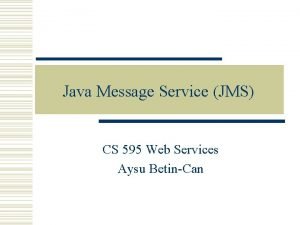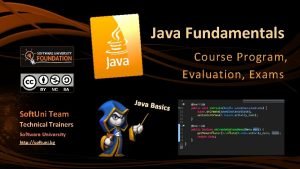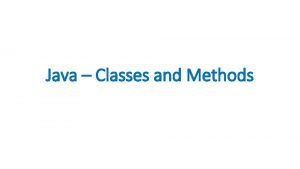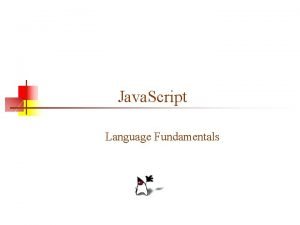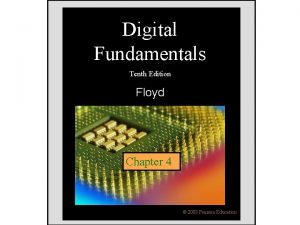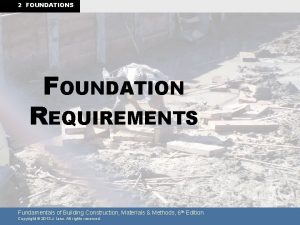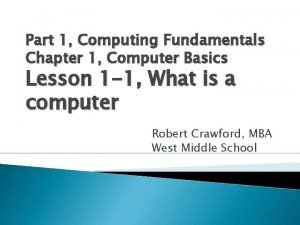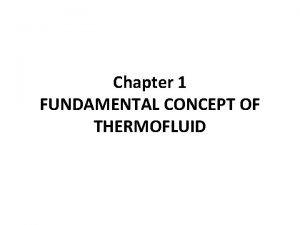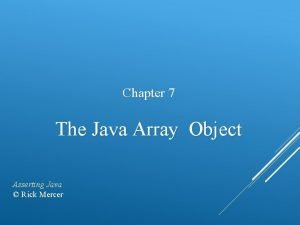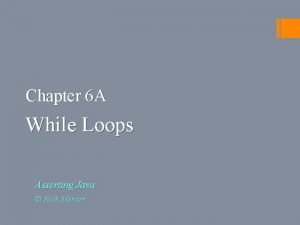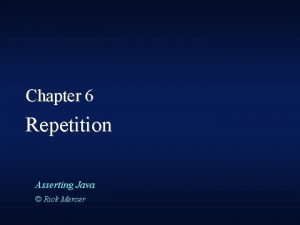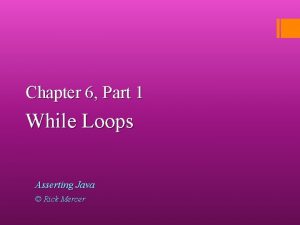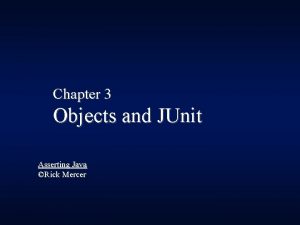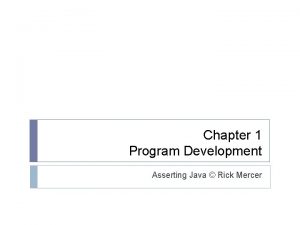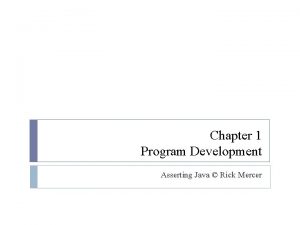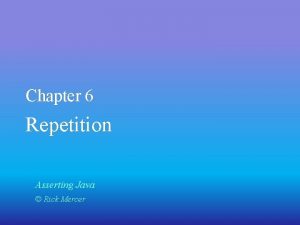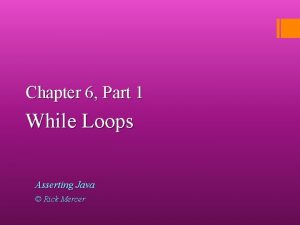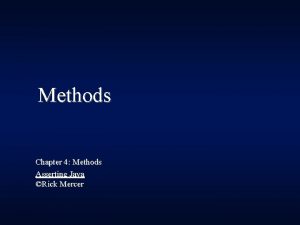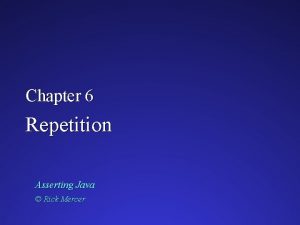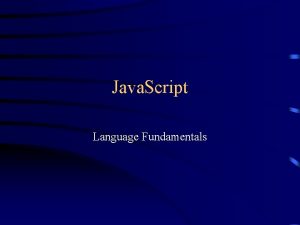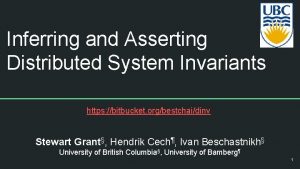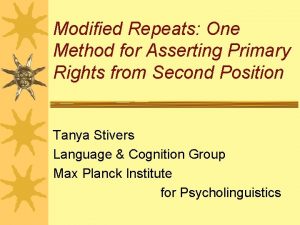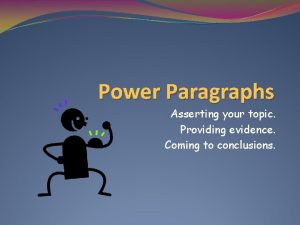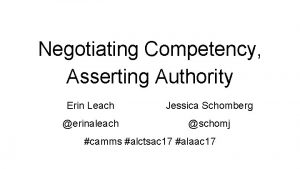Java Fundamentals Asserting Java Chapter 2 Introduction to

























- Slides: 25

Java Fundamentals Asserting Java Chapter 2: Introduction to Computer Science ©Rick Mercer

Outline Distinguish the syntactical parts of a program • Tokens: special symbols, literals, identifiers, • Output with System. out. println • An executable program as a Java class with a main method Introduce two of Java's primitive types: int and double

Preview: A Complete Java program import java. util. Scanner; // Read number from user and then display its squared value public class Read. It. And. Square. It { public static void main(String[] args) { double x; double result = 0. 0; Scanner keyboard = new Scanner(System. in); // 1. Input System. out. print("Enter a number: "); x = keyboard. next. Double(); // 2. Process result = x * x; // 3. Output System. out. println(x + " squared = " + result); } }

Programs have 4 types of tokens The Java source code consists of 1) 2) 3) 4) special symbols + < = >= && || identifiers customer. Name total. Bill n reserved identifiers int while if void literals 123 "A String" true These tokens build bigger things like variables, expressions, statements, methods, and classes. Also, comments exist for humans to read // Document your code if it is unreadable : -(

Overloaded Symbols Some special symbols are operators and have different things in different contexts • with two integers, + sums integers 2 + 5 evaluates to the integer 7 • with two floating point literals, + sums to floating point (types make a difference) 2. 0 + 5. 0 evaluates to 7. 0 • with two strings, + concatenates "2" + "5" evaluates to the new string "25"

Identifiers An identifier is a collection of certain characters that could mean a variety of things There are some identifiers that are Java defines: sqrt String Integer System in out We can make up our own new identifiers test 1 last. Name daily. Number MAXIMUM $A_1

Valid identifiers Identifiers have from 1 to many characters: 'a'. . 'z', 'A'. . 'Z', '0'. . '9', '_', $ • Identifiers start with letter a 1 is legal, 1 a is not • can also start with underscore or dollar sign: _ $ • Java is case sensitive. A and a are different Which letters represent valid identifiers? a) abc b) m/h c) main d) $$$ e) 25 or 6 to 4 f) 1_time i) a_1 j) student Number k) String

Reserved Identifiers (keywords) A keyword is an identifier with a pre-defined meaning that can't be changed it's reserved double int Other Java reserved identifiers not a complete list boolean break case catch char class default do double else extends float for if import instance. Of int long new private public return void while

Literals -- Java has 6 Floating-point literals 1. 234 -12. 5 1. 2 3. . 4 1 e 10 0. 1 e-5 String literals "characters between double quotes" "'10" "_" Integer literals (Integer. MIN_VALUE and Integer. MIN_VALUE) -1 0 1 -2147483648 2147483647 Boolean literals (there are only two) true false Null (there is only this one value) null Character literals 'A' 'b' 'n' '1' ' '

Comments • Provide internal documentation to explain program • Provide external documentation with javadoc • Helps programmers understand code--including their own // on one line, or • There are three type of comments /* between slash star and star slash you can mash lines down real far, or */ /** * javadoc comments for external documentation * @return The square root of x */ public static double sqrt(double x)

General Forms The book uses general forms to introduce parts of the Java programming language General forms provide information to create syntactically correct programs • Anything in yellow boldface must be written exactly as shown (println for example) • Anything in italic represents something that must be supplied by the user • The italicized portions are defined elsewhere

Output Statements A statement, made up of tokens, is code that causes something to happen while the program runs General Forms for three output statements System. out. print( expression ); System. out. println( expression ); Example Java code that writes text to the console System. out. print("hello world. "); System. out. println(); // print a blank line System. out. println("Add new line after this");

General Form: A Java program // This Java code must be in a file named class-name. java public class-name { public static void main(String[] args) { statement(s) } } // Example Program stored in the file Hello. World. java import java. util. Scanner; public class Hello. World { public static void main(String[] args) { Scanner keyboard = new Scanner(System. in); System. out. print("Enter your name: "); String my. Name = keyboard. next(); // keyboard input System. out. println("Hi Rick"); System. out. println("This is " + my. Name); } }

Primitive Numeric Types Type: A set of values with associated operations Java has many types, a few for storing numbers • Stores integers in int variables • Store floating-point numbers in double variables A few operations for numeric types • Assignment Store a new value into a variable • Arithmetic +, -, * (multiplication), / • Methods Math. sqrt(4. 0) Math. max(3, -9) See class Math for others

Variables to store numbers To declare and give initial value: type identifier = initial-value; Examples int credits. A = 4; double grade. A = 3. 67; String name = "Chris"; int hours = 10; boolean ready = hours >= 8;

Assignment We change the values of variables with assignment operations of this general form variable-name = expression; Examples: double x; int j; // Undefined variables // can not be evaluated j = 1; x = j + 0. 23;

Memory before and after The primitive variables x and j are undefined at first Variable Name Initial Value j ? Assigned Value 1 ? means undefined x ? 1. 23 The expression to the right of = must be a value that the variable can store assignment compatible x = "oooooh nooooo, you can't do that"; // <-Error j = x; // <-Error, can't assign a float to an int

Assignment double bill; What is value for bill now? _____ bill = 10. 00; bill = bill + (0. 06 * bill); What is value for bill now? ____ Which letters represent valid assignments given these 3 variable initializations? String s = "abc"; int n = 0; double x = 0. 0; a) b) c) d) s n x s = = n; x; n; 1; e) f) g) h) n x s n = = 1. 0; 999; "abc" + 1; 1 + 1. 5;

Arithmetic Expressions Arithmetic expressions consist of operators such as + - / * and operands such as 40, 1. 5, pay. Rate and hours. Worked Example expression used in an assignment: gross. Pay = pay. Rate * hours. Worked; Another example expression: 5 / 9 * (fahrenheit - 32); For the previous expression, Which are the operators? _____ Which are the operands? _____

Arithmetic Expressions Arithmetic expressions take many forms or or or a numeric variable a numeric constant expression + expression - expression * expression / expression (expression ) double x = 1. 2; 100 or 99. 5 1. 0 + x 2. 5 - x 2*x x / 2. 0 (1 + 2. 0)

Precedence of Arithmetic Operators Expressions with more than one operator require some sort of precedence rules: evaluated in a left to right order in the absence of parentheses Evaluate 2. 0 + 4. 0 - 6. 0 * 8. 0 / 6. 0 * - / + Use (parentheses) for readability or to intentionally alter an expression: double C, F; F = 212. 0; C = 5. 0 / 9. 0 * (F - 32); What is the current value of C ____?

Math functions Java’s Math class provides a collection of mathematical and trigonometric functions returns 4. 0 Math. min(-3, -9) returns -0 Math. max(-3. 0, -9. 0) returns -3. 0 Math. abs(4 - 8) returns 4 Math. floor(1. 9) returns 1. 0 Math. pow(-2. 0, 4. 0) returns 16. 0 Math. sqrt(16. 0)

int Arithmetic variables are similar to double, except they can only store whole numbers (integers) int an. Int = 0; int another = 123; int no. Can. Do = 1. 99; // ERROR Division with integers is also different • Performs quotient remainder whole numbers only an. Int = 9 / 2; an. Int = an. Int / 5; an. Int = 5 / 2; // an. Int = 4, not 4. 5 What is an. Int now? ___

The integer % operation The Java % operator returns the remainder an. Int = 9 % 2; // an. Int ___1___ an. Int = 101 % 2; What is an. Int now? ___ an. Int = 5 % 11; What is an. Int now? ___ an. Int = 361 % 60; What is an. Int now? ___ int quarter; quarter = 79 % 50 / 25; What is quarter? ___ quarter = 57 % 50 / 25; What is quarter now? ___

Integer Division, watch out … int celcius, fahrenheit; fahrenheit = 212; celcius = 5 / 9 * (fahrenheit - 32); What is the current value of celcius _____?
 Chapter 2 lab java fundamentals
Chapter 2 lab java fundamentals![[author] java message service - jms fundamentals course [author] java message service - jms fundamentals course](data:image/svg+xml,%3Csvg%20xmlns=%22http://www.w3.org/2000/svg%22%20viewBox=%220%200%20200%20200%22%3E%3C/svg%3E) [author] java message service - jms fundamentals course
[author] java message service - jms fundamentals course Java message service
Java message service Examssoft
Examssoft Constructor in java
Constructor in java Language
Language Pearson education inc
Pearson education inc Fundamental of nursing chapter 1
Fundamental of nursing chapter 1 Fundamentals of electric circuits chapter 4 solutions
Fundamentals of electric circuits chapter 4 solutions Fundamentals of corporate finance chapter 6 solutions
Fundamentals of corporate finance chapter 6 solutions Digital fundamentals chapter 4
Digital fundamentals chapter 4 Chapter 24 magnetism magnetic fundamentals answers
Chapter 24 magnetism magnetic fundamentals answers Chapter 73 tire wheel and wheel bearing fundamentals
Chapter 73 tire wheel and wheel bearing fundamentals Chapter 1 health and wellness fundamentals
Chapter 1 health and wellness fundamentals The circuit chapter 9
The circuit chapter 9 Fundamentals of electric circuits chapter 7 solutions
Fundamentals of electric circuits chapter 7 solutions Building the right foundations/fundamentals
Building the right foundations/fundamentals Computer fundamentals chapter 1
Computer fundamentals chapter 1 Fundamentals of corporate finance, chapter 1
Fundamentals of corporate finance, chapter 1 Fundamentals of thermal-fluidsciences chapter 1 problem 25p
Fundamentals of thermal-fluidsciences chapter 1 problem 25p Fundamentals of information systems chapter 1
Fundamentals of information systems chapter 1 Fundamental of information system
Fundamental of information system Chapter 17 fundamentals of nursing
Chapter 17 fundamentals of nursing Chapter 6 fingerprints
Chapter 6 fingerprints Hotel and lodging operations
Hotel and lodging operations Back channeling nursing
Back channeling nursing
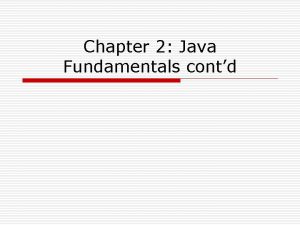
![[author] java message service - jms fundamentals course [author] java message service - jms fundamentals course](https://slidetodoc.com/wp-content/uploads/2020/09/381247_2ef7a792adac8a30d3544ffd2fa051e8-300x225.jpg)
